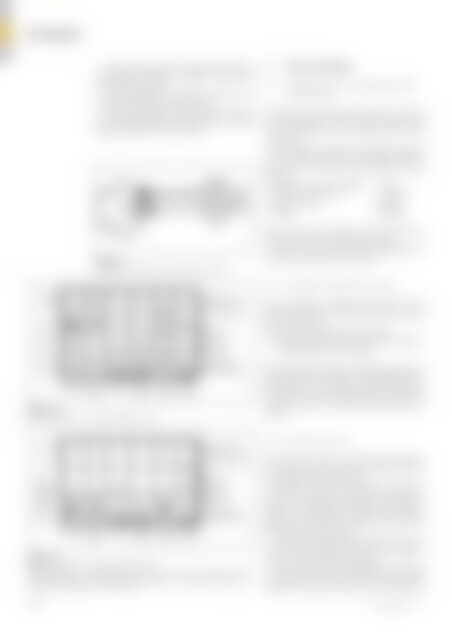eb - Elektrische Bahnen Bahnenergieversorgungssystem der DB erneut bestätigt (Vorschau)
Sie wollen auch ein ePaper? Erhöhen Sie die Reichweite Ihrer Titel.
YUMPU macht aus Druck-PDFs automatisch weboptimierte ePaper, die Google liebt.
Pantographs<br />
The step structure allows to measure wire wear by<br />
calculating the difference of height of each part of<br />
the contact wire surface.<br />
The wire tested was a standard grooved AC-120<br />
according EN 50149 on both test rigs.<br />
In total nine different strip materials, four plain<br />
and five impregnated ones with a copper content of<br />
20 up to 48 % in mass were tested.<br />
Figure 9:<br />
Principle of wear measurement at Hoffmann test bench.<br />
3 Parts of project<br />
3.1 Comparison of results gained at the<br />
two test rigs<br />
The objective of this first series of tests was to isolate<br />
the contribution from the carbon material itself<br />
in the phenomenon of wear without action of the<br />
electric arcs.<br />
The following common test routine was established<br />
for each bench with the identical conditions<br />
also in or<strong>der</strong> to compare results between the two<br />
test rigs:<br />
• Width of carbon strip samples 35 mm<br />
• Specific contact force<br />
3,1 N/mm<br />
• Specific current<br />
8 A/mm<br />
• Speed<br />
180 km/h<br />
Force and current conditions were retained as the<br />
extreme values given by the questionnaire.<br />
Speed is the maximum value generating only<br />
little arcing level on each test bench.<br />
3<br />
mm 3 /km<br />
2,5<br />
wear of contact strips →<br />
2<br />
1,5<br />
1<br />
0,5<br />
0<br />
B plain A imp1 A plain B imp A imp2 C imp<br />
20% 26% 25% 35%<br />
Figure 10:<br />
Wear of contact strips – Comparison between test rigs.<br />
average value +<br />
standard deviation<br />
Polimi (1st series)<br />
Hoffmann<br />
(1st series)<br />
Hoffmann<br />
(2nd series)<br />
average value -<br />
standard deviation<br />
3.2 Materials of the contact strips<br />
The tests related to samples provided by two European<br />
manufacturers. The materials called A and B<br />
exist in the versions<br />
• plain carbon, called A plain and B plain<br />
• and impregnated carbon called A imp and B imp<br />
+ copper content in % of weight<br />
That means carbons of type A and B have seen an additional<br />
industrial treatment of metal impregnation.<br />
The material C, very common in Europe, will be also<br />
tested but only in its impregnated version with 35 %<br />
of metal C imp 35 %, the pure version not being on<br />
market.<br />
1,5<br />
mm² / 10 6<br />
→<br />
wear of contact wire<br />
related to CSP<br />
1<br />
0,5<br />
0<br />
B plain A imp1 A plain B imp A imp2 C imp<br />
20% 26% 25% 35%<br />
average value +<br />
standard deviation<br />
Polimi (1st series)<br />
Hoffmann<br />
(1st series)<br />
Hoffmann<br />
(2nd series)<br />
average value -<br />
standard deviation<br />
Figure 11:<br />
Wear of contact wires – Comparison between test rigs.<br />
Hoffmann and Polimi 1 st series, means that the tests of a contact strip were carried out on the<br />
patina deposited by the strip of the previous test; Hoffmann 2 nd series means that the test of<br />
contact strip is carried out on a machined wire<br />
3.3 Duration of a test<br />
The duration of a test or more precisely the number<br />
of contact strip passages is one of the more important<br />
parameter to be consi<strong>der</strong>ed.<br />
Actually, a minimum test duration is necessary to<br />
ensure that mechanical and electrical energy dissipated<br />
in the interface area between the materials in<br />
contact and equilibrium is reached. That duration<br />
depends on the test bench design but also may vary<br />
from one material to another.<br />
Therefore, arbitrarily setting identical test durations<br />
for the test materials may lead to overestimating<br />
or un<strong>der</strong>estimating wear speeds.<br />
Hence, electric wear was appreciated by seeking<br />
the conditions for which the wear rate of the pure<br />
copper wire reached a constant value characteristic<br />
190 111 (2013) Heft 3

















